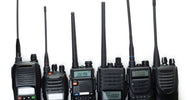
How To Create a Radio Environment With Multiple Brands
, by Jesus Moraga, 6 min reading time

, by Jesus Moraga, 6 min reading time
For anyone who manages a construction site, organizes large events, or sets up disaster response plans, staying connected is one of the most important aspects. But what if you’re stuck with a jumble of different radio brands like Motorola, Hytera, and Icom? Everything from competing frequencies to mismatched settings can create frustration, miscommunication, and lost time. When people’s safety is on the line, errors can’t happen.
But here’s the good news. With a bit of effort, you can create a radio environment with multiple brands. This guide will break down how to align different radio brands into one functional network, covering programming, testing, troubleshooting, and even using accessories to extend capability. By the end, you’ll have the tools and know-how to make these types of headaches a thing of the past.
Different radio brands often have unique technical specs, so your first step is to check compatibility. Two-way radios need to operate within the same frequency bands, UHF or VHF, to communicate directly.
For example, you can pair Motorola and Hytera radios together on UHF frequencies, which penetrate buildings well. Icom radios, which commonly use VHF frequencies, are ideal for longer outdoor coverage due to their specialty in the marine and aviation industries.
Communication mode is another aspect to consider. If your team uses older analog Motorola radios, they won’t connect with digital Hytera equipment unless the Motorola radios have an analog mode.
Some radios offer mixed-mode operations, allowing them to switch between modes and making integration easier. The foundation of success for communicating with two-way radios is verifying and assigning the best bands and modes based on the situation.
Programming radios aligns all devices in your system, regardless of brand. Each model uses specific software and setup steps, so you’ll need to allocate some time to adjust and fine-tune these settings.
For instance, Motorola’s XPR series uses its proprietary customer programming software. This allows you, as the customer, to set shared frequencies, privacy codes, and channel configurations. Similarly, other brands like Hytera and Icom radios rely on their specific programming suite tool.
To streamline this process for yourself, create a programming table. Document which devices are set to what frequency and channel. This can avoid confusion and allow you to conduct periodic spot checks to evaluate if everything still works as you intend.

Test the radios in the environment where the staff will use them the most. Think about the actual challenges of the operation or event area. Let’s use a construction site as an example, situate one radio operator inside a steel-walled building and another in an open area of the site. Then, test how the radio handles interference through solid structures.
If you’re coordinating an outdoor community event, test the range of the radios at the edges of the venue. This way, you know you have communication at every point of the event space. These tests also allow you to adjust channels, modes, or frequencies.
Problems can arise when using multiple brands, but all it takes is a little know-how to solve them. Watch for signs like static, dropped calls, and radios that stop responding. These issues usually stem from mismatched settings or traffic on shared frequencies.
Here’s a breakdown of common issues and solutions:
Troubleshooting these issues as they happen will keep the system running smoothly, even in high-stress conditions.
Accessories can solve many challenges, especially when blending different two-way radio brands into one cohesive system. Motorola radios pair well with hands-free earpieces like the PMLN7270A, which has a low profile that is discreet but also great for hazardous locations. Hytera’s external speakers are durable enough to perform in a wide range of temperatures and noise levels. Icom mobile radios offer high-efficiency antennas that improve signal quality in fringe areas.
Repeaters can extend the range of your setup. Some offer hybrid systems that can perform well in all environments and with analog and digital compatibility. Hytera’s simplified repeater, the RD625, integrates seamlessly into digital and analog systems, and it has its own built-in power supply. Choosing compatible, high-quality accessories can contribute to increased overall performance.
Even the best system fails if your team doesn’t know how to use it. Everyone on staff should know the basics, like how to switch channels, adjust volume, and troubleshoot issues.
Here’s a little tip not everyone knows: Hytera radios may need to reboot after updates, which is something not all Motorola or Icom systems require.
Set clear protocols and make sure all staff members are aware of them. If security staff use Motorola radios, then logistics can use Hytera, and outdoor scouts can have Icom units. Next, assign specific channels to various roles. These are some of the ways you can keep communication simple even under pressure.

Regular maintenance keeps your radios reliable. Dust and moisture can damage any device, but cleaning can extend its lifespan. Even waterproof models like the Icom F1000T benefit from maintenance.
Rotate rechargeable batteries to prevent uneven wear. Since chargers are brand-specific and maybe even model-specific, label them clearly and make spares easily available to minimize downtime.
Learning how to create a radio environment using multiple radio brands doesn’t have to be a headache. When you focus on compatibility, programming, and team training, you can integrate Motorola, Hytera, and Icom radios into one reliable system. With the details covered and the right accessories in place, you’ll be ready for anything.
Need personalized advice or top-tier equipment? Contact Atlantic Radio Communications today! Our experts specialize in crafting seamless, high-performing radio systems that can even integrate refurbished two-way radios to meet your team’s specific needs. Don’t just settle for patchwork solutions. Use Atlantic Radio Communications for a reliable setup.